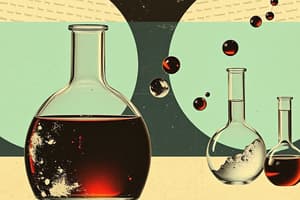Podcast
Questions and Answers
What is the basic unit of all matter?
What is the basic unit of all matter?
Which subatomic particle carries a positive charge?
Which subatomic particle carries a positive charge?
What type of bond forms when nonmetal atoms share electrons?
What type of bond forms when nonmetal atoms share electrons?
Which type of bond occurs when metal atoms lose or gain electrons?
Which type of bond occurs when metal atoms lose or gain electrons?
Signup and view all the answers
What does the atomic number of an atom represent?
What does the atomic number of an atom represent?
Signup and view all the answers
How can the structure of a molecule be described?
How can the structure of a molecule be described?
Signup and view all the answers
What is the result of electron transfer between metals and nonmetals during the formation of ionic compounds?
What is the result of electron transfer between metals and nonmetals during the formation of ionic compounds?
Signup and view all the answers
What holds together the oppositely charged ions in an ionic lattice?
What holds together the oppositely charged ions in an ionic lattice?
Signup and view all the answers
Why does sodium react with chlorine according to the text?
Why does sodium react with chlorine according to the text?
Signup and view all the answers
What is at the heart of ionic theory, based on the information provided?
What is at the heart of ionic theory, based on the information provided?
Signup and view all the answers
Why do metals typically become positively charged cations during the formation of ionic compounds?
Why do metals typically become positively charged cations during the formation of ionic compounds?
Signup and view all the answers
Study Notes
Exploring Chemistry's Foundations: Atoms, Molecules, and Ions
Chemistry is a scientific discipline that centers around understanding matter and its transformations through various interactions and reactions. To grasp the essence of this vast field, let's delve into three fundamental concepts: atoms, molecules, and ions; pivotal building blocks that help us make sense of our physical world.
Atoms
At their most basic level, all matter consists of tiny indivisible units called atoms. Each element in the periodic table has its unique type of atom, identified by its atomic number—the number of protons it contains. Protons carry a positive charge while electrons have a negative charge. In a neutral state, an equal number of protons and electrons exist within each atom.
Atomic mass specifies how much a particular atom weighs compared to carbon-12. This measure takes into account both the number of protons and neutrons present in the nucleus.
Molecules
Individual atoms group together to form chemical compounds known as molecules. A bond forms when one or more electrons are shared between two atoms. When nonmetal atoms share electrons, they create covalent bonds; when metal atoms lose or gain electrons, ionic bonds occur.
The structure of a molecule can be described using molecular formulae like CH₃Cl or H₂O, which indicate the relative numbers of carbon, hydrogen, chlorine, and oxygen atoms respectively. These symbols show the elements' names with a numerical prefix corresponding to the number of atoms involved.
Ions
Ionic bonds result from electron transfer between metals and nonmetals during the formation of ionic compounds. During this process, metals typically lose electrons and become positively charged cations, whereas nonmetals often accept electrons and turn into negatively charged anions. Ionic lattices consist of ordered arrays of these oppositely charged ions held together by electrostatic forces.
Establishing charges and utilizing them to understand chemical behavior lies at the heart of ionic theory. For example, sodium reacts with chlorine because both atoms want to achieve stable configurations: Na+ loses one electron to obtain eight valence electrons, and Cl⁻ gains one electron to attain eight electrons around its nucleus.
In summary, mastery of chemistry begins with recognizing the interplay among fundamental particles such as atoms, molecules, and ions. As we continue exploring these compelling concepts further, you will discover why chemistry connects science and everyday life so seamlessly!
Studying That Suits You
Use AI to generate personalized quizzes and flashcards to suit your learning preferences.
Description
Explore the foundational concepts of chemistry by learning about atoms, molecules, and ions. Understand how atoms form elements, molecules create compounds, and ions interact through ionic bonds. Delve into the world of chemistry to discover the building blocks of matter and their significance in scientific study.




